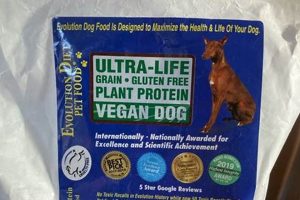Canine diets mirroring ancestral eating habits are a popular choice for pet owners seeking to provide biologically appropriate nutrition. These diets often prioritize protein-rich formulations utilizing novel protein sources, such as bison or venison, and grain-free carbohydrate sources like sweet potatoes. This approach aims to reflect the nutritional profile a dog’s wild ancestors might have consumed.
The appeal of such feeding strategies lies in the perceived health advantages, including improved digestion, enhanced energy levels, and shinier coats. Proponents suggest that ingredients aligning with a dog’s evolutionary past can minimize sensitivities and optimize overall well-being. The movement towards these specialized diets reflects a growing awareness of the impact of nutrition on canine health and longevity. Historically, commercial dog food relied heavily on grains and processed ingredients; this shift represents a move towards higher-quality, more natural components.
The following sections will delve into the specific ingredient composition, potential advantages and disadvantages, and considerations for selecting a similar dietary regimen for one’s canine companion. Careful evaluation and consultation with a veterinarian are recommended before transitioning a dog’s diet.
Guidance on Selecting a Diet Reflecting Ancestral Canine Nutrition
Choosing a canine diet inspired by ancestral feeding habits requires careful consideration. The following tips outline key aspects to evaluate when considering such a nutritional approach for a dog.
Tip 1: Protein Source Evaluation: Prioritize products listing a named animal protein (e.g., bison, venison, salmon) as the primary ingredient. Avoid those with generic “meat” or “animal by-product” designations, as these lack transparency regarding protein origin and quality.
Tip 2: Carbohydrate Composition Analysis: Opt for grain-free formulas utilizing alternative carbohydrate sources such as sweet potatoes, lentils, or peas. These ingredients provide essential nutrients and fiber without the potential allergenic properties associated with grains in some dogs.
Tip 3: Fat Content Scrutiny: Examine the fat content and sources listed on the ingredient panel. Healthy fats, such as those derived from fish oil or flaxseed, contribute to skin and coat health. Ensure the fat percentage aligns with the dog’s activity level and life stage.
Tip 4: Ingredient List Assessment: Scrutinize the entire ingredient list for potential allergens or sensitivities. Common culprits include corn, wheat, soy, and artificial additives. A shorter, more natural ingredient list generally indicates higher quality.
Tip 5: Life Stage Considerations: Select a formulation specifically designed for the dog’s age, breed size, and activity level. Puppy, adult, and senior formulations have varying nutritional requirements to support optimal health at each life stage.
Tip 6: Transition Process Management: Implement a gradual transition to the new diet to minimize digestive upset. Slowly incorporate the new food into the existing diet over a period of 7-10 days, increasing the proportion of the new food each day.
By carefully evaluating these factors, owners can make informed decisions regarding a diet that reflects ancestral canine nutritional principles, potentially leading to improved health and vitality in their dogs.
Consulting with a veterinarian or a qualified canine nutritionist is strongly advised to ensure the chosen diet meets the individual needs of the dog.
1. Novel Protein Sources
The inclusion of novel protein sources is a defining characteristic when seeking canine nutrition that aligns with a dog’s evolutionary dietary habits. This strategy centers on utilizing protein ingredients less commonly found in traditional dog food formulations.
- Reduced Allergenicity
Using proteins like bison, venison, or duck can minimize allergic reactions in dogs with sensitivities to more conventional proteins like chicken or beef. This approach addresses food intolerances, leading to improved digestive health and reduced skin irritations.
- Enhanced Palatability
The unique flavors associated with novel proteins can increase a dog’s interest in and acceptance of their food. This is particularly beneficial for picky eaters or those with decreased appetites.
- Balanced Amino Acid Profile
Novel protein sources contribute to a complete and balanced amino acid profile, essential for muscle development, tissue repair, and overall physiological function. Adequate amino acid intake supports a dog’s physical well-being and performance.
- Mimicking Ancestral Diets
The selection of proteins such as bison and venison is rooted in the concept of providing a diet that resembles what a dog’s wild ancestors would have consumed. This approach aligns with the philosophy of biologically appropriate nutrition.
By incorporating these novel protein sources, targeted nutrition aims to offer an alternative for dogs with sensitivities, improve palatability, ensure a complete amino acid profile, and potentially align with a dog’s genetic predisposition for a particular dietary composition.
2. Grain-Free Formulation
The absence of grains in canine diets has become a prominent feature, particularly in product lines that emphasize a return to ancestral feeding principles. This formulation strategy seeks to eliminate ingredients like corn, wheat, and soy, often replaced with alternative carbohydrate sources.
- Reduced Allergen Exposure
Grains are potential allergens for some dogs. Eliminating these ingredients can reduce the likelihood of allergic reactions, resulting in decreased skin irritation, digestive upset, and related health issues. Grain-free options aim to improve the overall well-being of sensitive animals.
- Mimicking Ancestral Diets
Wild canids consumed minimal quantities of grains. Formulations without grains seek to more closely replicate the natural diet of a dog’s ancestors. The approach emphasizes a focus on protein and alternative carbohydrate sources mirroring a presumed natural diet.
- Glycemic Index Considerations
Grain-free formulations often utilize carbohydrates with a lower glycemic index, such as sweet potatoes or legumes. This can lead to a more gradual release of glucose into the bloodstream, potentially beneficial for managing blood sugar levels and promoting sustained energy.
- Improved Digestibility
While grains are digestible for many dogs, some individuals experience difficulty processing them. Grain-free options can improve nutrient absorption and reduce digestive stress, especially in dogs with sensitive stomachs.
The absence of grains represents a significant shift in canine nutrition, reflecting a focus on minimizing allergens, mimicking ancestral diets, considering glycemic impact, and potentially improving digestibility. These factors contribute to the overall health and vitality of canine companions.
3. Digestibility
Digestibility, in the context of canine nutrition, refers to the extent to which a dog’s digestive system can break down food components and absorb the resulting nutrients. A dog food characterized by high digestibility ensures that a greater proportion of the ingested nutrients are utilized by the animal’s body, contributing to optimal health and minimizing waste production. In the context of formulations that mirror ancestral eating habits, such as products featuring novel protein sources and grain-free composition, digestibility assumes particular significance. The rationale behind prioritizing these specialized diets often rests on the premise that they are inherently more digestible for dogs than conventional, grain-heavy alternatives. This premise is supported by observations of improved stool quality, reduced flatulence, and enhanced energy levels in some dogs transitioning to such diets. For example, a dog with a history of digestive sensitivities experiencing frequent diarrhea on a grain-based food might exhibit improved digestive function with firmer stools and reduced episodes of gastrointestinal distress when switched to a formulation emphasizing digestibility.
The connection between formulations and digestibility is not, however, universally guaranteed. Several factors beyond ingredient selection influence a food’s digestibility, including ingredient processing methods, kibble size and shape, and the individual dog’s digestive physiology. A protein source, even a novel one, may be poorly processed, rendering it less digestible. Similarly, a food lacking appropriate fiber levels may lead to either constipation or diarrhea, impacting nutrient absorption. Furthermore, dogs with pre-existing conditions like inflammatory bowel disease may experience continued digestive issues irrespective of the food’s theoretical digestibility. Therefore, a blanket assumption of superior digestibility based solely on the dietary philosophy would be misleading. Consider, for example, two products; one containing a novel protein but utilizes lower-quality rendered meals and excessive non-digestible fiber and another that uses a traditional protein source but it is high quality and uses proper fiber ratio. The latter would show high digestibility than the former.
In conclusion, while the concept of mirroring ancestral canine diets emphasizes ingredients considered inherently digestible, the actual digestibility of any particular food is a multifaceted issue. Factors such as ingredient quality, processing techniques, fiber content, and the individual dog’s health status all play critical roles. Dog owners considering a diet to support digestibility should look at the whole equation. Blind adherence to one dietary philosophy without considering digestibility factors could result in disappointment, and may even worsen a dog’s digestive health. Consultation with a veterinarian is essential to assess the suitability of any diet, taking into account all relevant factors to ensure optimal digestive function and nutrient absorption.
4. Nutrient Density
Nutrient density, when applied to canine diets, refers to the concentration of essential nutrients relative to the caloric content of the food. A nutrient-dense food provides a high proportion of vitamins, minerals, amino acids, and essential fatty acids per calorie, minimizing the need for large feeding volumes to meet a dog’s nutritional requirements. In the context of dietary approaches inspired by ancestral canine feeding patterns, nutrient density is often a key objective. Formulations featuring novel protein sources, limited carbohydrate content, and minimal processed ingredients are typically designed to maximize the concentration of essential nutrients in each serving.
The pursuit of nutrient density in ancestral canine diets stems from several factors. First, wild canids, consuming whole prey animals, would naturally ingest a highly concentrated source of nutrients. Replicating this necessitates a departure from conventional diets relying heavily on fillers and processed ingredients. A diet rich in animal protein, healthy fats, and naturally occurring vitamins and minerals aligns more closely with the nutritional profile of wild prey. Secondly, optimizing nutrient density can be particularly beneficial for active dogs or those with specific health conditions. Higher energy demands and compromised digestive function both benefit from a diet that delivers concentrated nutrition in smaller, more digestible portions. For instance, a working dog expending significant energy would benefit greatly from a high amount of nutrient density to properly function.
However, achieving optimal nutrient density requires careful formulation and ingredient selection. Simply including high levels of protein or fat does not guarantee a nutritionally complete and balanced diet. Essential micronutrients must be present in adequate amounts and bioavailable forms. Furthermore, excessive nutrient density can be detrimental, potentially leading to digestive upset or nutrient imbalances. The key to a successful dietary approach lies in formulating a diet that is both nutrient-dense and appropriately balanced for the individual dog’s life stage, activity level, and health status. Thus, pet owners need to assess carefully the content to select appropriate nutrition. Consulting with a veterinary nutritionist is crucial to ensure that a selected diet aligns with the dog’s specific requirements, preventing deficiencies or excesses.
5. Palatability
Palatability, in the context of canine nutrition, denotes the appeal of a food to a dog’s senses, primarily taste and smell, but also encompassing texture and appearance. It directly influences a dog’s willingness to consume a food willingly and consistently. Within the realm of dog food that echoes ancestral eating habits, palatability represents a crucial determinant of success. Even a nutritionally sound formulation will prove ineffective if a dog refuses to eat it. Consequently, manufacturers of brands that focus on protein sources and grain-free formulations often prioritize enhancing the palatability of their products through various means. One common approach involves incorporating palatable fats and oils, such as fish oil or sunflower oil, to improve the taste and aroma of the kibble. Similarly, the inclusion of dried fruits or vegetables can add both nutritional value and textural variety, potentially increasing a food’s palatability. Consider, for instance, a dog that has never tried bison. The success of a product relying on bison as a main ingredient relies on palatability of the formulation to make it acceptable to consume. Without it, the dog might reject it.
The palatability of food mirroring ancestral nutritional composition can be influenced by several factors. One important determinant stems from the novel protein sources it often includes. Bison, venison, and salmon, while nutritious, present distinct flavor profiles compared to conventional ingredients like chicken or beef. Some dogs may readily accept these novel tastes, while others require a period of adjustment or may demonstrate a preference for more familiar flavors. Furthermore, the absence of grains can impact palatability, as grains often contribute to the texture and sweetness of dog food. Consequently, manufacturers may need to compensate for the lack of grains by adjusting the levels of other ingredients to achieve a palatable product. Moreover, food aversion resulting from illness or negative experiences can influence palatability. A dog that associates a specific food with gastrointestinal distress may develop an aversion to that food, regardless of its nutritional value or objective palatability.
In conclusion, palatability serves as an indispensable attribute of dog food, playing a pivotal role in ensuring adequate nutrient intake and maintaining a dog’s overall health. For formulations mirroring ancestral dietary habits, optimizing palatability involves carefully balancing novel protein sources, carbohydrate composition, and flavor enhancers to create a product that dogs find appealing and readily consume. Dog owners should consider their dog’s individual preferences and any potential food aversions when selecting a diet. If introducing a new diet, gradual transition and attentive observation will maximize the chance of a successful outcome. Consulting with a veterinarian or a canine nutritionist can provide valuable guidance in selecting a palatable and nutritionally appropriate diet for an individual dog.
6. Ingredient Quality
The quality of ingredients is paramount in determining the nutritional value and overall health benefits of any dog food, including those formulated to reflect ancestral diets. For brands under consideration, meticulous sourcing and careful processing of ingredients are crucial factors influencing the product’s ability to deliver optimal canine nutrition.
- Protein Source Integrity
The origin and handling of protein sources, such as bison, venison, or salmon, significantly impact their nutritional value. High-quality protein sources are derived from animals raised in humane conditions, free from antibiotics and hormones, and processed using methods that preserve their amino acid profile. The inclusion of substandard protein sources compromises the food’s ability to support muscle development, tissue repair, and overall physiological function.
- Carbohydrate Purity and Source
While grain-free formulations often utilize alternative carbohydrate sources like sweet potatoes or peas, the quality of these ingredients is equally important. Carbohydrates should be sourced from reputable suppliers and processed minimally to retain their nutritional value. The presence of fillers, artificial additives, or low-quality carbohydrate sources diminishes the food’s nutrient density and can potentially trigger adverse reactions in sensitive dogs.
- Fat Source and Composition
The type and quality of fat sources influence the overall health benefits of the food. Healthy fats, such as those derived from fish oil or flaxseed, provide essential omega-3 fatty acids, crucial for skin and coat health, cognitive function, and immune system support. The inclusion of rendered fats or oils of unknown origin compromises the food’s nutritional value and can potentially introduce harmful contaminants.
- Micronutrient Bioavailability
The bioavailability of vitamins and minerals is essential for ensuring optimal nutrient absorption and utilization. High-quality ingredients are naturally rich in micronutrients, while synthetic vitamins and minerals should be included in forms that are readily absorbed by the dog’s digestive system. The presence of poorly bioavailable micronutrients limits the food’s ability to support overall health and well-being.
The connection between ingredient quality and the nutritional efficacy is undeniable. Formulations emphasizing ancestral diets can only deliver on their promise of improved health and vitality if they utilize high-quality, carefully sourced, and minimally processed ingredients. Dog owners must scrutinize ingredient lists and seek out brands with transparent sourcing practices to ensure that their canine companions receive optimal nutrition.
7. Life Stage Specificity
Life stage specificity constitutes a critical consideration in canine nutrition, dictating the appropriate balance of macronutrients and micronutrients required to support optimal health at different phases of life. This principle is particularly relevant when evaluating formulations, given the varying nutritional needs of puppies, adult dogs, and senior dogs. A diet formulated for one life stage may not be appropriate or beneficial for another.
- Puppy Formulations
Puppy-specific formulations prioritize higher levels of protein and fat to support rapid growth and development. These diets often include increased concentrations of calcium and phosphorus to promote bone mineralization. The kibble size is typically smaller and more easily digestible for young pups with developing digestive systems. For puppy formulations mirroring ancestral diets, the emphasis remains on high-quality animal protein sources and grain-free carbohydrate options, tailored to meet the unique needs of growing canines. An example of this is a large-breed puppy formula, which often has a lower calcium to phosphorus ratio in order to prevent the rapid bone growth that can lead to skeletal disorders in large breeds.
- Adult Formulations
Adult dog formulations are designed to maintain optimal body condition and support overall health and vitality. These diets typically contain moderate levels of protein, fat, and carbohydrates, balanced to meet the energy requirements of adult dogs with varying activity levels. The focus shifts towards maintaining lean muscle mass and supporting a healthy immune system. For adult formulations, the dietary composition should take into account the breed, size, and activity level of the dog. For example, a working dog would require a formulation with higher fat content compared to a less active small breed dog.
- Senior Formulations
Senior dog formulations address the age-related changes that can impact a dog’s health and well-being. These diets often feature reduced calorie and fat content to help prevent weight gain, as well as increased levels of fiber to promote digestive health. Joint support ingredients, such as glucosamine and chondroitin, are commonly added to help maintain mobility and reduce inflammation. Senior formulations with ancestral compositions adapt these general considerations by ensuring novel protein sources and easily digestible carbohydrates are used, further supporting digestion and nutrient absorption in older dogs with potential digestive sensitivities. The goal here is to extend the years of life and improve the quality of life for senior dogs.
By tailoring macronutrient ratios, micronutrient concentrations, and ingredient selection to the specific requirements of each life stage, formulations can optimize canine health and promote longevity. Dog owners are advised to select diets specifically formulated for their dog’s current life stage and consult with a veterinarian to ensure that the chosen diet meets their individual needs.
Frequently Asked Questions
The following questions and answers address common inquiries regarding canine nutrition, with a particular focus on dietary approaches that emphasize ingredients mirroring those consumed by dogs’ wild ancestors. These answers provide general information and should not substitute professional veterinary advice.
Question 1: Are novel protein sources inherently superior to traditional protein sources in canine diets?
Novel protein sources, such as bison or venison, can offer advantages for dogs with sensitivities or allergies to common proteins like chicken or beef. However, superiority is not inherent. The quality and digestibility of any protein source, regardless of its novelty, are crucial factors. A well-sourced and properly processed chicken meal may be more beneficial than a poorly sourced or improperly processed novel protein.
Question 2: Is a grain-free diet necessary or beneficial for all dogs?
A grain-free diet is not a universal requirement for canine health. Many dogs thrive on diets containing grains. Grain-free diets are primarily indicated for dogs with diagnosed grain allergies or sensitivities. Eliminating grains without a clear medical reason may not provide any additional health benefits and could potentially lead to nutritional imbalances if not properly formulated.
Question 3: What are the potential risks associated with feeding a diet mirroring ancestral canine eating habits?
Potential risks include nutritional imbalances if the diet is not properly formulated, bacterial contamination if raw food is included, and digestive upset during the transition period. It is crucial to select a commercially available diet that meets AAFCO standards or consult with a veterinary nutritionist to ensure proper balance and safety.
Question 4: How can one assess the ingredient quality in a commercial diet formulated to reflect ancestral diets?
Ingredient quality can be assessed by carefully reviewing the ingredient list, researching the manufacturer’s sourcing practices, and looking for certifications or quality control measures. Prioritize diets listing named animal protein sources as the primary ingredients and avoid those containing excessive fillers, artificial additives, or vague ingredient descriptions.
Question 5: Does a higher price point necessarily indicate a superior product?
A higher price point does not automatically guarantee superior quality or nutritional value. While more expensive diets may contain higher-quality ingredients or more specialized formulations, it is essential to evaluate the ingredient list, nutrient profile, and manufacturing practices to determine the true value of the product.
Question 6: How important is life-stage specificity in dietary selection?
Life-stage specificity is crucial for providing optimal nutrition throughout a dog’s life. Puppies, adult dogs, and senior dogs have distinct nutritional requirements, and diets should be formulated accordingly. Selecting a diet specifically designed for the dog’s current life stage helps ensure adequate nutrient intake and supports overall health and well-being.
The key takeaways include the importance of evaluating individual needs, scrutinizing ingredient quality, and consulting with veterinary professionals for guidance.
The following section explores practical tips for transitioning a dog to a new diet.
Evaluating Canine Dietary Choices
This exposition has illuminated various facets pertinent to canine nutrition, particularly within the context of dietary formulations that seek to emulate ancestral eating habits. The composition of protein, carbohydrates, fats, digestibility, nutrient density, palatability, ingredient quality, and life stage specificity were examined.
The information presented serves as a foundation for informed decision-making. Prudent evaluation of individual canine needs, coupled with veterinary consultation, remains paramount in optimizing canine health and well-being. Furthermore, continuous advancements in nutritional science will likely lead to refined dietary strategies, warranting ongoing evaluation of feeding practices.




![Is Cheese Dog Food Good? [Benefits & Risks] World’s Most Delicious Foods: Must-Try Dishes from Every Country Is Cheese Dog Food Good? [Benefits & Risks] | World’s Most Delicious Foods: Must-Try Dishes from Every Country](https://lisasfoods.com/wp-content/uploads/2025/11/th-729-300x200.jpg)


